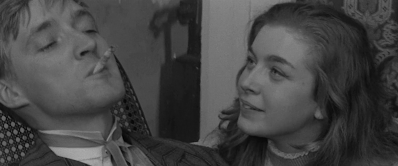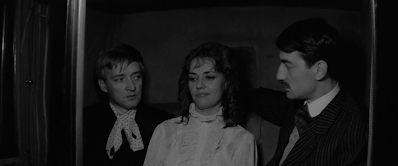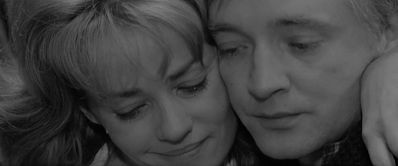Married in 1913 to Franz Hessel, German journalist Helen Grund
also had a relationship with his best friend Henri-Pierre Roché for some thirteen
years. Franz was so accommodating, he divorced Helen so that she and Roché
could live together. In the summer of 1922, Helen and Franz Hessel remarried,
although the affair between Roché and Hessel continued… sound familiar? Roché wrote
the novel Jules et Jim about the relationship with his lover and best
friend and this inspired François Truffaut to make the film regarded as one of
the finest of the French New Wave.
Until now I’ve had to take that on trust as, shockingly I
know, I’ve not seen the film before hence the borrowed line from The Guardian’s
series, but now the BFI are providing with the perfect opportunity to fill in
those New Wave gaps with a UK-wide celebration of François Truffaut from
January to February 2022, including re-releases of The 400 Blows (1959) –
which I have seen - and Jules Et Jim (1962) and, as the saying goes,
many more!
For a “new wave” La Nouvelle Vague is a bit ancien regime as this film is halfway between Georges Méliès and now but Jules Et Jim still feels fresh, inventive and a step-change in style from most post war films. It’s not just the director’s bold use of narrative, a voice-over that actually works to enhance the dramatic impact for example, and the sweeping camerawork from cinematographer Raoul Coutard, but the performances the director evokes. This may be entitled Jules and Jim, but the central focus is Catherine and Jeanne Moreau’s incredible energy as this most unpredictable and curious of characters. The only one who can reliably comment on Catherine is the narrator and he (Michel Subor) is recalling actions and events that take both the men years to absorb and comprehend and, right to the end, they don’t really know what she is capable of. Neither do we.
 |
| Jeanne Genie |
Moreau is unpredictable and yet totally in control of her
expression, managing to convey Catherine’s mercurial contradictions in ways
that appear to have only just occurred. She’s reacting to her character’s
surprise at herself, as unknowable as the statue which resembles her, and which
first grabs Jules and Jim’s attention. It’s not a free-running tale of
escalating passion like Goddard might make but a controlled and very deliberate
retelling of a mystery passed onto Truffaut by Roché.
Jaques and Julien were inseparable, and they never
knew that their neighbours found their relationship ambiguous. They ate
together in small restaurants. They bought each other fine cigars… everyone
called them Don Quixote and Sancho Panza.
The film starts in the 1900s, during la Belle Époque and features two bohemians in their search for experience and direction. Their friendship had no equivalent in love… but Jules and Jim are friends for life, enjoying the same things and attuned in their thoughts, often competing for the same partners but with Jules (Oskar Werner) a writer from Austria less successful than the more extrovert Jim (Henri Serre). Jules’ relationship with the free-spirited Thérèse (Marie Dubois) illustrates his soft centre as she is soon looking for a more defined companion (any relation to my own experience with Debbie the Redcoat in Butlins 1982 is entirely pertinent). It’s a foretaste of love's labours to come.
 |
| Oscar Werner and Marie Dubois |
The two men become transfixed by a statue in a slide show,
their ideal of womanly beauty, an immovable objet d’amour. They go to
visit the monument on an island in the Adriatic Sea, spending an hour admiring
this unresponsive goddess before meeting a woman in Paris who has the same
shaped face, she is Catherine and she’ll be a lot more trouble to worship.
Not this one, Jim…
Truffaut highlights the moment of connection when Jules
looks at Catherine and she looks at him by marking out a space on screen and
then blacking out the image around it, something of a standard device by later
in the decade but a surprise here? Jules and Catherine seem to be destined from
this point and she soon becomes a feature of his and Jim’s togetherness.
 |
| There were three people in this marriage... |
She soon reveals her eccentric energy by drawing a
moustache and pretending to be “Thomas” for the iconic race across a railway
bridge. She wins by cheating, showing a very “male” initiative… and I wonder if
there’s a parallel here with Antonioni’s male and female alienation? Probably
not, I’m out of the shallows here but Moreau was equally at home in the previous
year’s La Notte running rings round Marcello Mastroianni.
The trio decide to holiday in the south and as they prepare for their trip, Catherine “burns lies” in her flat with Jim and tells him she has “vitriol” for the eyes of men who lie… before pouring what looks like a bottle of acid down the sink. The film’s tone shifts in moments like this and whilst we’re shocked, we assume she’s joking… At another time, as the boys talk about the play they’ve seen, Catherine gets tired of their intellectualisation and jumps into the Seine… Jim and Jules don’t get to establish why she was so reckless, and she smiles quietly to herself soaked through between the two on the cab ride home.
 |
| Henri Serre and Oskar Werner |
Jim’s relationship with Gilberte (Vanna Urbino) is on a
different footing by comparison and she doesn’t meet Jules until many years
later; a complexity which says everything about Catherine’s influence on the two
men.
The carefree years end as war begins and Jules and
Catherine move to Austria to get married before he is enlisted in the conflict which
separates him from his best friend. There’s an extensive sequence of archival
footage which looks like a mix of documentary and reconstructions from the
silent era; I wish I knew the sources – probably a mix of French and German?
She jumped at men the way she had jumped into the
river.
The three are reunited after the war at Jules and
Catherine’s house in the Black Forest where they live with their daughter, Sabine.
Things have changed and the marriage has not satisfied Catherine, leaving Jules
clinging on, accepting anything she wants as the price of her presence. She begins
a relationship with Jim, even under the same roof, and the men are able to
accommodate this as the price of their own friendship and the women they love’s
happiness.
Will even this state of affairs last though as Catherine still
hasn’t found what she’s looking for… I mean, I haven’t even mentioned Albert (Serge
Rezvani) and she writes a song with him. I’m still not sure what Catherine’s
restlessness signifies and that’s the point. Every reason to rewatch this
enthralling film on the big screen in 2022!
Georges Delerue’s score is also a thing a beauty, matching the emotional force with skill and lovely melody.
The two-month Truffaut season at BFI Southbank, starts on Friday 7th and runs to the end of February 2022. Curated by BFI programmer at large Geoff Andrew, it will feature thematic strands, so that audiences can access Truffaut’s immense body of work more easily. There are also talks and a course, no stone left unturned in this re-examination of an unparalleled life in film.
Jules et Jim plays from 4th February on
the Southbank and elsewhere and a new BFI Blu-ray will follow.










%2Blook%2Bsmile.png)

%20hill.JPG)

No comments:
Post a Comment